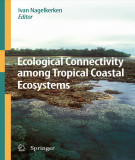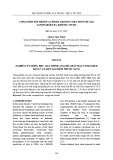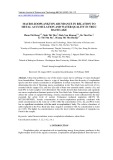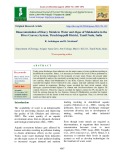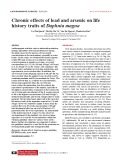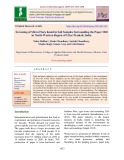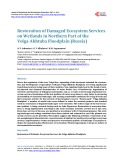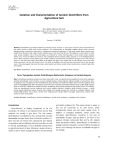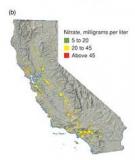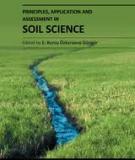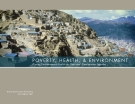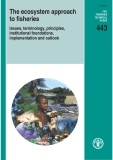
Water ecosystems leads
-
Ebook "Ecological connectivity among tropical coastal ecosystems" provides a first-time comprehensive review of the major ecological interactions across tropical marine ecosystems that result from the mutual exchange of nutrients, organic matter, fish, and crustaceans. A group of leading authors from around the world reviews the patterns and underlying mechanisms of important biogeochemical and biological linkages among tropical coastal ecosystems in 15 chapters.
 617p
617p  giangdongdinh
giangdongdinh
 28-05-2024
28-05-2024
 5
5
 1
1
 Download
Download
-
In the recent decates, wastewater treatment has attracted the attention of scientists due to health and environmental issues that pollutants can cause. One of the leading sources of water pollutions is without doubt industrial activities. Every day, huge amounts of industrial wastewater are discharged into water body, and this severely affects not only the health of all living forms but also the quality of the whole ecosystem.
 6p
6p  viwyoming2711
viwyoming2711
 15-12-2020
15-12-2020
 12
12
 0
0
 Download
Download
-
Urban lake pollution is one of the serious issues due to suffering of waste discharged from householders. However, there is a gap of knowledge about the diversity of zooplankton species and how metals accumulate in zooplankton in urban ecosystems. We addressed this by determining the rule of blooming macro-zooplankton in the Truc Bach lake and levels of two essential metals: copper (Cu), and zinc (Zn) and of three non-essential metals: arsenic (As), and lead (Pb) in water samples were determined.
 8p
8p  angicungduoc5
angicungduoc5
 13-06-2020
13-06-2020
 8
8
 0
0
 Download
Download
-
Today water discharges from industries are the major causes of water pollution resulting in destabilized ecosystems. Hence, it is necessary to monitor the levels of these pollutants as well as develop technologies for the treatment of waste water. Hence, the present study was attempted to analyse the commonly occurring heavy metals in water and organisms in two stations, Musiri and Mukkombu of the River Cauvery.
 6p
6p  trinhthamhodang4
trinhthamhodang4
 22-03-2020
22-03-2020
 13
13
 1
1
 Download
Download
-
Anthropogenic activities such as industrial production, mining, agriculture and transportation are among the main causes for the increase of trace metal concentrations in the environment, especially in water bodies. In this study, we evaluated the chronic impacts of lead (Pb) and arsenic (As) on Daphnia magna, a crucial organism to aquatic ecosystems, at several concentrations (0, 5, 25, 50, 150 and 250 µgl-1 of Pb and 0, 5, 25, 50 µgl-1 of As) for 21 days. The organism’s life history traits, including survivorship, maturation, and reproduction, were recorded daily.
 6p
6p  chauchaungayxua2
chauchaungayxua2
 07-01-2020
07-01-2020
 27
27
 0
0
 Download
Download
-
Pulp and paper industries are considered as one of the major polluters of the environment all over the world. These industries are the fifth largest contributor to water pollution. Pulping process, used for paper manufacturing leads to release of toxic chemicals or effluents into the environment and pollute water, air and soil therefore it is a major threat to ecosystem. A number of microbes have been found in the nearby soil of paper mill that are useful in the breakdown of environmental pollutants.
 6p
6p  kequaidan2
kequaidan2
 13-12-2019
13-12-2019
 27
27
 1
1
 Download
Download
-
Due to the regulation of the river Volga flow, expanding of the territories intended for construction and development of agriculture wetlands Volga-Akhtuba floodplain are being significantly transformed and are losing many of their qualities. Non-regulated loads lead to the break of natural physical and chemical characteristics of water bodies, loss of biodiversity, degradation of structure and functions of biological communities and, as a result, to decreasing of potential ecosystem services.
 5p
5p  mentospurefresh
mentospurefresh
 29-11-2019
29-11-2019
 26
26
 3
3
 Download
Download
-
Denitrification is generally considered an anaerobic process. However, in recent years it has been shown that bacteria can also reduce nitrate to nitrite under aerobic conditions. The characterization of biologically available nitrogen forms and their biological cycling mechanisms is important for ecological and agricultural implications. In this study, aerobic nitrate reducers were isolated from greenhouse soil.
 6p
6p  vitamix
vitamix
 15-02-2019
15-02-2019
 27
27
 1
1
 Download
Download
-
The following paragraphs describe a set of activities leading to development of a watershed and water quality management plan for the MRB. The tasks described below create a framework for the study. It is anticipated that these tasks will be accomplished in a collaborative fashion; study goals will be set by the Interagency Study Team, and individual partners will develop data, models, and other pertinent information to accomplish each task in cooperation with the other partners.
 15p
15p  tay_thi_le
tay_thi_le
 21-02-2013
21-02-2013
 65
65
 4
4
 Download
Download
-
Cold seeps occur in geologically active and passive continental margins, where pore waters enriched in methane are forced upward through the sediments by pressure gradients. The advective supply of methane leads to dense microbial communities with high metabolic rates. Anaerobic methane oxidation presumably coupled to sulphate reduction facilitates formation of carbonates and, in many places, generates extremely high concentrations of hydrogen sulphide in pore waters.
 46p
46p  japet75
japet75
 30-01-2013
30-01-2013
 34
34
 2
2
 Download
Download
-
Water temperature plays an important role in signaling biological functions such as spawning and migration, and in affecting metabolic rates in aquatic organisms. Altering natural water temperature cycles can impair reproductive success and growth patterns, leading to long-term population declines in fisheries and other classes of organisms. Warmer water holds less oxygen, impairing metabolic function and reducing fitness.
 0p
0p  saimatkhauroi
saimatkhauroi
 01-02-2013
01-02-2013
 48
48
 2
2
 Download
Download
-
Both human activities and natural activities can change the physical, chemical, and biological characteristics of water, and will have specific ramifications for human and ecosystem health. Water quality is affected by changes in nutrients, sedimentation, temperature, pH, heavy metals, non-metallic toxins, persistent organics and pesticides, and biological factors, among many other factors (Carr and Neary 2008). Following are brief discussions of these major contaminants.
 52p
52p  saimatkhauroi
saimatkhauroi
 01-02-2013
01-02-2013
 54
54
 4
4
 Download
Download
-
The ocean absorbs a significant portion of carbon dioxide (CO2) emissions from human activities, equivalent to about one-third of the total emissions for the past 200 years from fossil fuel combustion, cement production and land use change (Sabine et al., 2004). Uptake of CO2 by the ocean benefits society by moderating the rate of climate change but also causes unprecedented changes to ocean chemistry, decreasing the pH of the water and leading to a suite of chemical changes collectively known as ocean acidification.
 163p
163p  mnemosyne75
mnemosyne75
 02-02-2013
02-02-2013
 56
56
 8
8
 Download
Download
-
The world's reliance on existing sources of energy and their associated detrimental impacts on the environment- whether related to poor air or water quality or scarcity, impacts on sensitive ecosystems and forests and land use - have been well documented and articulated over the last three decades. What is needed by the world is a set of credible energy solutions that would lead us to a balance between economic growth and a sustainable environment.
 0p
0p  cucdai_1
cucdai_1
 22-10-2012
22-10-2012
 57
57
 7
7
 Download
Download
-
The soil ecosystem provides services such as carbon sequestration, nutrient cycling, water purification, provisioning of industrial and pharmaceutical goods, and a mitigating sink for chemical and biological agents. However, the soil is subject to various degradation processes. Its relation with the hydrosphere, biosphere, and atmosphere makes the interacting processes even more complex. Moreover, as the soilhuman interactions increase, threats, leading to a series of impacts on soil health, become more important....
 406p
406p  cucdai_1
cucdai_1
 14-10-2012
14-10-2012
 82
82
 22
22
 Download
Download
-
e elevated water table is a prominent feature of the Florida ecosystem. Frequent surface appearance of the aquifer has produced a patchwork of wetlands, streams, rivers and lakes.This presents an issue for the efficient extraction of the phosphate rock deposit by draglines. If the opencast pit contains water, dragline operators have difficulty identifying the boundary between the ore and overburden, potentially result- ing in the loss of ore or dilution by barren rock.
 68p
68p  tieuyeuquai456
tieuyeuquai456
 05-10-2012
05-10-2012
 66
66
 3
3
 Download
Download
-
Three of the world’s greatest challenges over the coming decades will be biodiversity loss, climate change, and water shortages. Biodiversity loss will lead to the erosion of ecosystem services and will increase vulnerability to the impacts of climate change. Climate change will lead to water scarcity, increased risk of crop failure, pest infestation, overstocking and permanent degradation of grazing lands and livestock deaths. Water shortages affect agricultural productivity, food security and human health.
 16p
16p  yeurauxanh88
yeurauxanh88
 01-10-2012
01-10-2012
 50
50
 1
1
 Download
Download
-
The pH values will bring effects in flora and fauna nearby, change the taste of water and lead to heavy corrosion in pipe lines. High conductivity naturally indicates the presence of ionic substances dissolved in the river water. However, the result showed that 90% of the study site exceeded the data reported for non-contaminated rivers due to excessive metal ions within the water. At the site nearer to kaolin industry the conductivity is 852 times higher than the non-polluted study site. The industrial discharge also changed the hardness in river water.
 76p
76p  lulanphuong
lulanphuong
 28-03-2012
28-03-2012
 94
94
 17
17
 Download
Download
CHỦ ĐỀ BẠN MUỐN TÌM








